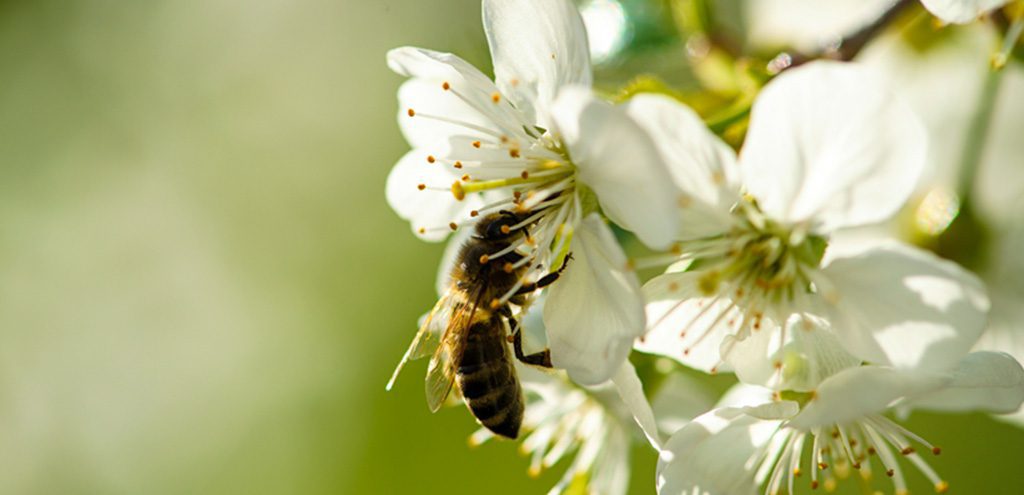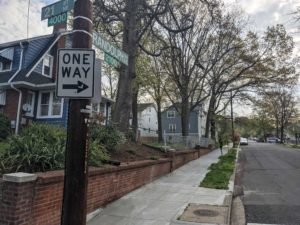
Happy National Pollinator Week! We typically spend this week at Casey Trees celebrating pollinators and spreading the word about what types of trees and plants you can add to your property to protect and encourage them (and we share more on that below). But thanks to a funny coincidence, we have a rescue story this year.
 Back in April, Casey Trees data whiz Vince was out on a morning walk with his dog minding his own business. While admiring the street trees in his North Michigan Park neighborhood however, he came across something he had never seen before: an enormous amount of bees latched onto one street tree! While swarms are a natural and healthy part of honey bee colony reproduction, they can be a nuisance and a little scary for the non-beekeeper.
Back in April, Casey Trees data whiz Vince was out on a morning walk with his dog minding his own business. While admiring the street trees in his North Michigan Park neighborhood however, he came across something he had never seen before: an enormous amount of bees latched onto one street tree! While swarms are a natural and healthy part of honey bee colony reproduction, they can be a nuisance and a little scary for the non-beekeeper.
Come spring time, healthy honey bees may run out of hive space and go out looking for a new place to call home. This activity is known as swarming. Bee swarms contain thousands of harmless, homeless honey bees. Swarming is a honey bee colony’s natural means of reproduction. In the process of swarming, a single colony splits into two or more distinct colonies. The queen flies off with half the worker bees from the hive to found a new colony. She leaves behind eggs the original colony will raise to be their new queen.
Figuring neither the bees nor the street tree were very happy with the situation, Vince did what anyone else would do – he googled what to do! Enter: the Swarm Squad.

The DC Beekeepers Alliance is a non-profit association of local beekeepers dedicated to honey bee health and beekeeper education in the Nation’s Capital. One of the many things they do is collect swarms of bees throughout the area, who often swarm in trees. Afterall, these are local, sustainable bees and many beekeepers would love to give them a new hive to call their own.
Vince sent off an email to the DC Beekeepers Alliance with the location of the tree and a few photos and walked on his merry way, hoping that the bees would be rescued. Turns out, the bees he found were the first official “Swarm Squad” response of 2021!
Since you never quite know when and where a swarm will occur and they’re healthy, eager bees looking for a new home, the Swarm Squad has dozens of beekeepers in every ward on standby waiting for a call. Which is how Vince met Erin, veteran beekeeper, Swarm Squad responder, and, as it turns out, Casey Trees volunteer! We told you bees and trees make a good pair.
 Thanks to Vince’s helpful location information and photos Erin was able to prepare appropriately to respond to the call and successfully collected the bees from the Hornbeam before the rain came in.
Thanks to Vince’s helpful location information and photos Erin was able to prepare appropriately to respond to the call and successfully collected the bees from the Hornbeam before the rain came in.
Each year the DC Beekeepers Alliance asks DC residents to keep an eye out for swarms of bees, and they organize a team of beekeepers to save and hive them. If you see a swarm, to ensure that it’s collected in a safe and timely manner, snap a picture and call/text the DC Beekeeper Alliance Swarm Squad at 202.255.4318. They’re really quick about this: There are dozens of beekeepers in every ward on standby waiting for a call.
Some Additional Pollinator Info
What exactly is a pollinator? Just bees? Not exactly. Butterflies, bees, birds, moths, bats, beetles, flies, and more. Any animal or insect that visits a flower can move pollen from one flower to another. Even the wind is a pollinator!
Pollinator plants and trees do a lot for the environment they’re in, including attract pollinators necessary for growing vegetable gardens and fruit trees, improve air quality, reduce stormwater runoff, improve habitat (shelter and food) for wildlife, increase the District’s biodiversity (variety of plant and animal species), and not to mention they add beauty (and value!) to your home.
We focus on trees you can plant, but there are so many native pollinator flowers and plants out there for you to add to your garden, community garden plot, or even a pot on your stoop.

